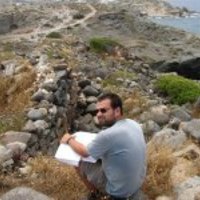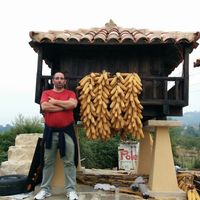
Marco Moderato
Università degli Studi di Foggia, Dipartimento di Studi umanistici. Beni culturali, Lettere, Scienze della Formazione, PhD Student in Landscape Archaeology
Archaeologist | Landscape archaeology, GIS, modelling, Indian Ocean Archaeology, spatial analysis
less
Related Authors
Michael Boyd
University of Cambridge
Emir O. Filipović
University of Sarajevo, Faculty of Philosophy
Alexandra Chavarria Arnau
Università degli Studi di Padova
Juan Antonio Quirós Castillo
University of the Basque Country, Euskal Herriko Unibertsitatea
Maja Gori
Consiglio Nazionale delle Ricerche (CNR)
Dan Hicks
University of Oxford
Maurizio Forte
Duke University
Sinclair W Bell
Northern Illinois University
Maria Cristina La Rocca
Università degli Studi di Padova
InterestsView All (56)










Uploads
Papers by Marco Moderato
The research project is focused on a region located between the eastern part of the Moselle department in France and the southern part of Saarland in Germany, between two river valleys (namely the Blies and the Sarre) characterized by a long-lasting human occupation, from prehistory to the present. The geomorphological context and the natural environment of the riverbanks and the low hills have been significantly interrelated with settlement patterns and human occupation.
Mesopotamia, the Red Sea coast, the Arabian Peninsula and the East. Archaeological diagnostics, surface surveys, the study of written sources
(historical cartography and epigraphs) together with a preliminary examination of the ceramic data of the Madayi site, however limited, provide
the opportunity to begin reconstructing its complex history; a history characterised by inter-ethnic and inter-religious relations that, however,
reveals in the background the economic dynamics that led the local aristocracies to strengthen their power and control over the territory, using
the revenues obtained from the exploitation of these trade routes.
In this context, archaeological surveys conducted in Madayipara (Kannur District, Kerala) have unearthed evidence of a complex network of settlements in the delta of the Kuppam River in Taliparamba which has almost disappeared today. The natural landscape has also changed over time, as the coastline slowly advanced and rivers changed their courses as well as their function. Traces of this hub or entrepôt can be found in the rich body of historical sources and cartography of the region, which suggests the presence of lively ports often associated with Jewish and Muslim communities, as well as in later maps drawn by European explorers. The historical sources, together with satellite imagery and results from archaeological surveys, can help us reconstruct a complex
settlement pattern, fully embedded within the trade networks of the medieval Indian Ocean.
la percezione, nel presente. Questo contributo si propone di fornire, in maniera reliminare, alcuni spunti di riflessione sull’archeologia dei paesaggi di Dyrrachium fra VI sec. a.C e VI sec. d.C. con particolare attenzione alle trasformazioni del paesaggio stesso e ai suoi effetti sulle attività umane
For too long, the studies of the settlement patterns and of the economic exploitation of the region have looked just to the main centres, playing very poor attention to the minor centers and to boundary areas of this territory. The main centers and sites in the area, in fact, are quite well known, while the minor settlements and the smaller towns
are now widely investigated by local Superintendence, Universities and archaeologists, but they have never been properly studied systematically from the topographic point of view. The archaeological team of Chieti University is applying a new approach to the study of the inland and mountainous settling patterns, in relationship with the surrounding territory, using new technologies and methodologies, as Remote Sensing, intensive survey projects, archaeometric analysis and non invasive geo-archaeological prospecting. The region was organised during the Iron Age and in Roman times in numerous settlements, very different in typologies, wideness, role, economic vocation and position, systematically and homogeneously planned from a hierarchic point of view. In late antiquity and during the Early Medieval age the patterns of the settlement changed the hierarchic organization. Moreover, they are
generally closely related to the local road network, to the most important via Claudia Nova (Tratturo Magno and Via degli Abruzzi in Medieval Age), sanctuaries and temples, transhumance trackways and their development is greatly influenced by their locations and functions toward the main settlements and the exploitation of the territory.
They are often the best sites to understand the mechanisms of settling as well as the role of the local productions and economy in the development and locations of these population patterns. It could be therefore very interestin to look at these minor typologies of sites contextualising them more closely and presenting the results of the recent excavations and surveys of Chieti University as sample cases. Moreover, the appendix is completely dedicated to the analytic study of an sample area, the Paelignan context, in order to show more closely a territorial case which has involved directly Sara Santoro in the surveys and researches.
The Adriatic sea has always been more than just a sea; it always worked as a link between the Mediterranean basin and the central Europe area as well as the West and the East. On both the Adriatic shores there are significant trade and productive centers that have been highlighted by recent archaeological investigations. In this study I will take into consideration four case studies: Risan (MNE), Durres (AL), Apollonia (AL) Phoinike (AL). These cities played an important role, during the late-Hellenistic roman age, in the historical dynamics of the Illyrian area, even if they showed different geographical, economical and political features. The goal of this studies is then to understand, starting from the archaeological data, how trade and productive activities manifest and organize themselves in these important centers.
valley system: while the latter is in fact shaped as a comb, with valleys running mainly perpendicular to the sea, linking the
inland areas to the coast, the former is arranged in longitudinal valleys, parallel to the sea and separated by lines of increasingly higher hills. This peculiar morphology concurred to set settlement patterns of the Albanian valleys where, inter-visibility and road networks played a very important role, as the view-shed and network analysis applied to this region show.
Keywords: inland, landscape, valley, viewshed, settlements.
The research project is focused on a region located between the eastern part of the Moselle department in France and the southern part of Saarland in Germany, between two river valleys (namely the Blies and the Sarre) characterized by a long-lasting human occupation, from prehistory to the present. The geomorphological context and the natural environment of the riverbanks and the low hills have been significantly interrelated with settlement patterns and human occupation.
Mesopotamia, the Red Sea coast, the Arabian Peninsula and the East. Archaeological diagnostics, surface surveys, the study of written sources
(historical cartography and epigraphs) together with a preliminary examination of the ceramic data of the Madayi site, however limited, provide
the opportunity to begin reconstructing its complex history; a history characterised by inter-ethnic and inter-religious relations that, however,
reveals in the background the economic dynamics that led the local aristocracies to strengthen their power and control over the territory, using
the revenues obtained from the exploitation of these trade routes.
In this context, archaeological surveys conducted in Madayipara (Kannur District, Kerala) have unearthed evidence of a complex network of settlements in the delta of the Kuppam River in Taliparamba which has almost disappeared today. The natural landscape has also changed over time, as the coastline slowly advanced and rivers changed their courses as well as their function. Traces of this hub or entrepôt can be found in the rich body of historical sources and cartography of the region, which suggests the presence of lively ports often associated with Jewish and Muslim communities, as well as in later maps drawn by European explorers. The historical sources, together with satellite imagery and results from archaeological surveys, can help us reconstruct a complex
settlement pattern, fully embedded within the trade networks of the medieval Indian Ocean.
la percezione, nel presente. Questo contributo si propone di fornire, in maniera reliminare, alcuni spunti di riflessione sull’archeologia dei paesaggi di Dyrrachium fra VI sec. a.C e VI sec. d.C. con particolare attenzione alle trasformazioni del paesaggio stesso e ai suoi effetti sulle attività umane
For too long, the studies of the settlement patterns and of the economic exploitation of the region have looked just to the main centres, playing very poor attention to the minor centers and to boundary areas of this territory. The main centers and sites in the area, in fact, are quite well known, while the minor settlements and the smaller towns
are now widely investigated by local Superintendence, Universities and archaeologists, but they have never been properly studied systematically from the topographic point of view. The archaeological team of Chieti University is applying a new approach to the study of the inland and mountainous settling patterns, in relationship with the surrounding territory, using new technologies and methodologies, as Remote Sensing, intensive survey projects, archaeometric analysis and non invasive geo-archaeological prospecting. The region was organised during the Iron Age and in Roman times in numerous settlements, very different in typologies, wideness, role, economic vocation and position, systematically and homogeneously planned from a hierarchic point of view. In late antiquity and during the Early Medieval age the patterns of the settlement changed the hierarchic organization. Moreover, they are
generally closely related to the local road network, to the most important via Claudia Nova (Tratturo Magno and Via degli Abruzzi in Medieval Age), sanctuaries and temples, transhumance trackways and their development is greatly influenced by their locations and functions toward the main settlements and the exploitation of the territory.
They are often the best sites to understand the mechanisms of settling as well as the role of the local productions and economy in the development and locations of these population patterns. It could be therefore very interestin to look at these minor typologies of sites contextualising them more closely and presenting the results of the recent excavations and surveys of Chieti University as sample cases. Moreover, the appendix is completely dedicated to the analytic study of an sample area, the Paelignan context, in order to show more closely a territorial case which has involved directly Sara Santoro in the surveys and researches.
The Adriatic sea has always been more than just a sea; it always worked as a link between the Mediterranean basin and the central Europe area as well as the West and the East. On both the Adriatic shores there are significant trade and productive centers that have been highlighted by recent archaeological investigations. In this study I will take into consideration four case studies: Risan (MNE), Durres (AL), Apollonia (AL) Phoinike (AL). These cities played an important role, during the late-Hellenistic roman age, in the historical dynamics of the Illyrian area, even if they showed different geographical, economical and political features. The goal of this studies is then to understand, starting from the archaeological data, how trade and productive activities manifest and organize themselves in these important centers.
valley system: while the latter is in fact shaped as a comb, with valleys running mainly perpendicular to the sea, linking the
inland areas to the coast, the former is arranged in longitudinal valleys, parallel to the sea and separated by lines of increasingly higher hills. This peculiar morphology concurred to set settlement patterns of the Albanian valleys where, inter-visibility and road networks played a very important role, as the view-shed and network analysis applied to this region show.
Keywords: inland, landscape, valley, viewshed, settlements.
Ad accomunare le ricerche e a favorire il confronto dei risultati è l’interesse a cogliere il rapporto tra città e territorio, con il ricorso allo scavo stratigrafico e alla ricognizione sistematica e con l’attenzione alle molteplici componenti insediative, infrastrutturali, produttive, commerciali, religiose e culturali, lette nel quadro del rapporto uomo-ambiente e dunque in una costante interazione tra indagine storico-archeologica e studi di carattere ambientale.
Nelle tre parti del volume, dedicate ai Paesaggi mediterranei, ai Paesaggi urbani e rurali in Italia e ai Paesaggi urbani e rurali della Puglia, insieme alla ricostruzione delle dinamiche insediative si approfondisce il trasferimento degli esiti della ricerca nella società, per la tutela del territorio attraverso forme di pianificazione sostenibile e per la comunicazione dei paesaggi antichi aperta ad un pubblico ampio.
In entrambi questi scenari si analizzano strategie e iniziative messe in atto o in via di progettazione, nel quadro di collaborazioni tra Istituti di ricerca ed Enti preposti alla tutela e alla valorizzazione del patrimonio culturale, per le quali mancava un aggiornamento recente rivolto in modo specifico al periodo romano.
Questi ambiti di indagine complementari hanno caratterizzato il progetto FIRB – Futuro in ricerca 2012 ‘Archeologia dei paesaggi della Puglia adriatica in età romana: tecnologie innovative per una pianificazione sostenibile e una fruizione identitaria’, con la collaborazione interdisciplinare tra diversi Atenei che, tra il 2013 e il 2016, è stata sperimentata in maniera sistematica su Egnazia. Per questo motivo, Gnatia e l’Ignatinus ager sono trattati con un particolare grado di approfondimento, in un confronto dinamico con le numerose realtà presentate.
L’uscita del volume segue la prematura scomparsa di Sara Santoro, che con straordinaria energia si è dedicata a questo lavoro nel quale si apprezzano i molteplici interessi che hanno caratterizzato la sua attività di studiosa brillante e rigorosa.
The strategic value of the region can be easily perceived in its main centres (Dyrrachium for instance), but is less known in its minor centres and especially for ports and harbours, which were relevant for small and middle range navigation. Recent surveys lead by the Italian Archaeological Mission in Durres are now investigating the region of Cape Rodoni (north of Dyrrachium). The results of the surveys combined with an accurate reconstruction of the geo-morphological dynamics provide an interesting picture of the settlement patterns in this area by the roman age and late antiquity. This paper shows the preliminary results of this study,as a first step in the indentification of changes and continuity between central powers (empires) and local authorities (Dyrrachium)
Taking mainly Caesar's text as our point of departure it is possible to guess the rough numbers of soldiers from both sides involved in the siege, as shown by Burns 1966: 81-82. The questions we ask are: did ancient Corfinium have the demographic capability to host such numbers? Where were Corfinium defensive structures located? Did the campus play a role in the management of the defence force of the city? Where was Caesar’ army camp positioned?
The mutual comparison between historical sources and topographical-archaeological data allows us to widen our general knowledge of an ancient, almost vanished, Roman city and to reflect on how different sources can generate more elaborate and accurate historical narratives.
Tra l’età ellenistica e il periodo romano Durazzo sembra quindi definirsi di volta in volta attraverso il confronto con le realtà etniche/culturali/politiche con le quali viene in contatto, appropriandosi dei vari aspetti e rielaborandone le caratteristiche in un processo di continua trasformazione.
In questa occasione si proporrà una riflessione sul tema delle trasformazioni culturali di Epidamnos/Dyrrachium attraverso la lettura dei molteplici aspetti che la caratterizzarono tra l’età ellenistica e l’età romana, dall’urbanistica alla strutturazione del territorio alla cultura materiale ed in particolare alla ceramica, e il loro inserimento all’interno del sistema culturale adriatico.